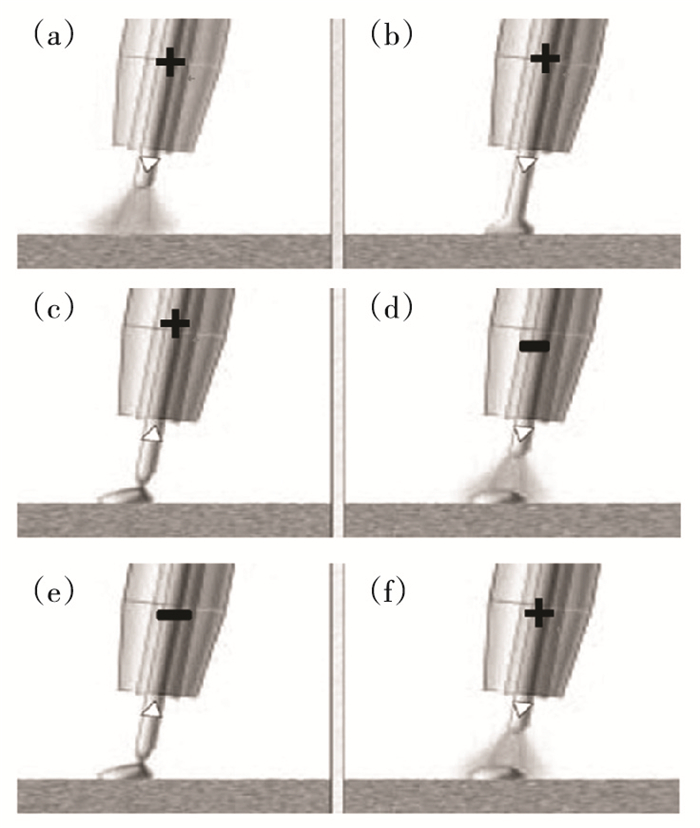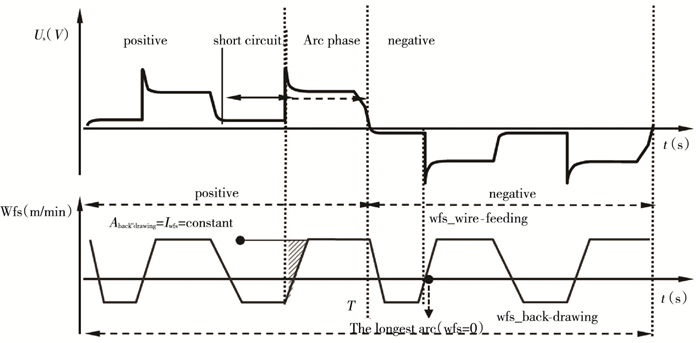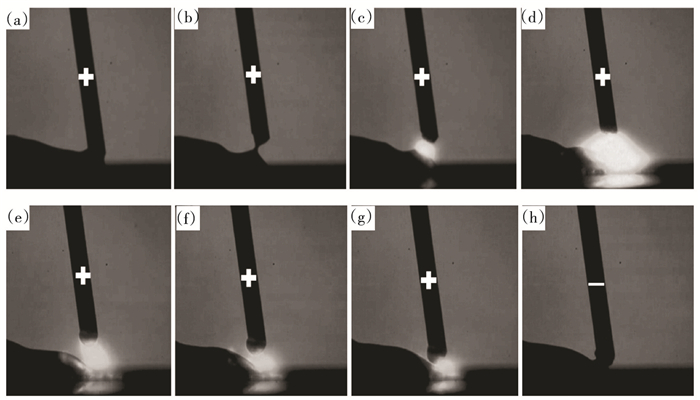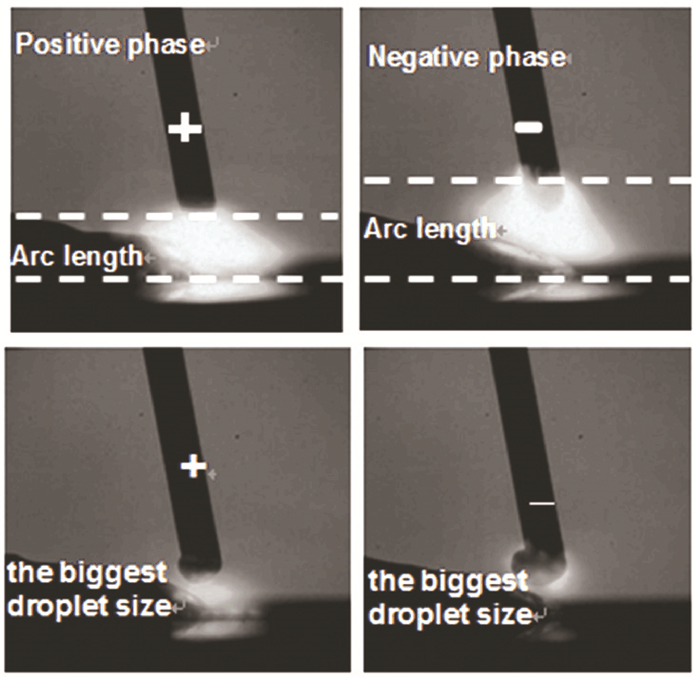Cold metal transfer (CMT) is applied widely in the field of car body joining, but using this method is hard to obtain a good shape coefficient and quality joint for the welding of thin sheets with gap[1]. CMT with polarity-exchanging is a new welding technology which is developed on the basis of CMT. Compared with traditional CMT, it can alternate the welding wire polarity to control the heat input and deposition rate. As a result, low heat input and excellent shape joint can be achieved. Due to the particular polarity-exchanging control system, the welding of some special structural parts that could barely be realized in the past can be realized now. Moreover, this method can further reduce welding heat input and spatter, yet improve the shape joint coefficient and increase the joint strength at the same time. Moreover, the stability of welding arc is higher. In addition, it is worth noting that in the welding of aluminum alloy, cathode atomization is employed to remove oxide film from aluminum alloy surface[2-5]. Thus the advantages of polarity-exchanging CMT are heat controlling, welding wire melting rate controlling, and the cathode atomization. As a result, the welding of some parts with big gap can be realized, which cannot be achieved by traditional CMT.
2 Principles and Equipment of CMT with Polarity-Exchanging 2.1 Principles of CMT with Polarity-ExchangingCMT with polarity-exchanging was conducted in the digital close-loop control mode. The monitoring of short circuit arc, polarity-exchanging, and wire direction-exchanging were achieved in the welding process. The wire feeding system was composed of the front and rear wire feeding units, by which wire could be fed forward and backward alternatively. The wire was fed as in planned forward/backward directions. The wire feeding speed of the front wire feeding unit was set according to the instructions of the general control system, with the characteristics of impulse from required frequency. On the other hand, the heat of the welding arc was decided by means of polarity-exchanging of the welding wire. As a result, high welding quality, low heat input, and good arc stability were achieved. During the welding process, the heat input was relatively low to prevent penetration and deformation of the thin metal sheets; CMT with polarity-exchanging was carried out in the alternating positive and negative electrode cycles. Compared with traditional CMT process, due to good controlling upon polarity-exchanging of the welding wire during the welding process, the heat input could be controlled alternatively[6-8].
The droplet transfer and arc behavior are shown in Fig. 1.

|
Fig.1 Schematic of droplet transfer in CMT with polarity-changing |
During a complete positive and negative electrode alternating cycle, CMT welding was accompanied by alternating of positive and negative polarities of the welding wire. Accordingly, the entire welding process was comprised of several different phases:
a) At the beginning of welding, the welding wire was working in the positive state with the welding arc ignition and therefore droplet was formed;
b) As welding progressed, welding arc disappeared along with lower welding current, on the other hand, droplet grew and propagated to the molten pool;
c) Welding current was reduced to the minimum level during the short circuit between the droplet and the molten pool;
d) At this moment, polarity-exchanging of the welding wire occurred from positive to negative state, so the wire moved in the opposite direction in line with re-ignition of welding arc;
e) This phase is similar to the second phase, but the wire was moving in opposite direction;
f) The polarity-exchanging occurred again in the end of a complete cycle with the final state turned positive.
When ignition of welding arc started again, the second welding cycle was generated with the same periodic droplet transfer process.
Numerical welding control system was utilized to monitor the start time of arc ignition, to reduce the welding current automatically until the arc disappeared, and to adjust wire feeding speed according to the pulse type and electrode exchanging, thus greatly improving the droplet transfer form and the joint shape coefficient simultaneously. After droplet disconnected from the end of the wire, the numerical control system was designed to increase the welding current again. In this period, the welding wire was fed forwards and polarity-exchanging occurred. Subsequently, welding arc was ignited again at beginning of the next cycle (See Fig. 2). It should be noted that, the aforementioned complicated processes occurred within a very short period, but with excellent coordination and well-ordered interactions. It indicates that the rapid exchange of electrode polarities greatly reduced the heat input on the heat affected zone (HAZ) during the welding process as well as the welding heat conduction. In addition, the desired joint shape coefficient and the high welding quality can also be achieved via adjusting the relative welding parameters and welding wire polarity-exchanging. Typical defects from CMT, such as spatter, were absent here.

|
Fig.2 Law of the welding parameters |
The interaction of the wire feeding system and the electrode polarity controlling system was pivotal to the welding results. Due to well-coordinated steps and well-ordered interactions, the CMT with polarity-exchanging was carried out as designed. So one can conclude that the technical level, software stability, performance accuracy, and physical state of the aforementioned equipment were the key factors for this technology.
In this work, wire feeding system was comprised of two independent wire feeding unit: the front one feeding the welding wire forwards and backwards at the scheduled frequency; the rear one extracting the welding wire out of the wire barrel, both of which were digitally programmed. In addition, each feeding unit was driven using an independent and high precision rotating motor, for the purpose to obtain desired control of wire feeding speed, and then to monitor the process of the welding wire moving and the physical behavior of droplet transfer.
The reasonable periodic exchanging of electrode polarities was realized via the electrode polarity control system. In addition, good match between the molten drop transfer and exchanging behavior was achieved along with improved welding arc behavior and weld shape coefficient.
2.2 Experimental Equipment of CMT with Polarity-Exchanging SystemThe welding equipment used for the experiment is as follows: PLC control system, robot operation system, wire feeding system, welding gun system, and polarity-changing welding power system. They coordinate with each other to work under the main control system, and realize the welding process of CMT with polarity-changing[9].
2.3 Technological Characteristics of CMT with Polarity-Exchanging SystemCMT welding technology is a great progress in the field of car BIW joining. Developed from traditional CMT, it not only possesses the advantages of CMT process, but also exhibits the following features:
1) CMT with polarity-exchanging, by means of changing of periodic electrode polarity, can master effectively control of the welding heat input under the same welding parameters. Compared with traditional CMT, its welding heat input is lower yet along with higher welding speed, and moreover it exhibits desired control upon the weld shape coefficient of welded joint in line with high-quality joint. In welding process, due to the periodical exchanging of electrode polarity, certain type of material, such as aluminum alloy, whose surface is prone to be oxidized, exhibited higher welding quality with less defects, e.g., oxide inclusions. However, using traditional CMT to weld Al alloy, more defects were often created.
2) Detrimental phenomenon like arc drift was efficiently hampered, so welding arc exhibited better stability throughout the entire welding process.
3) Favorable adjustability of exchanging performance was obtained. In the process of welding wire polarity-exchanging, in order to address the required welding shape coefficient, the cycle number of positive and negative polarities within the given time could be accurately adjusted, which showed good control upon wire melting speed. In this work, in the welding of the thin Al alloy plate, high quality joint without deformation and inclusions was obtained. As we know, large gap between two plates was detrimental to welding joint quality. However, here it is shown that this unfavorable effect could be alleviated via adjusting the deposition rate.
3 Test Results and Analysis 3.1 Arc Process Analysis of CMT with Polarity-ExchangingThe droplet transfer and arc behavior of polarity-exchanging CMT were similar to that of traditional CMT: due to the heat effect of welding arc, short circuit was generated through the contact of the droplet at the end of the wire and the molten pool. In the meanwhile, for the effect of gravity, electro-magnetic force, and the molten pool surface tension, the molten droplet fell into the molten pool, accompanied by extraction of the welding wire. Subsequently, re-ignition of the welding wire occurred and the second cycle was thereby started.
Calculation of the physical momentum value was conducted to describe the separation of the droplet and the end of the welding wire. It depends on the wire forward-feeding speed and the wire back-drawing speed, and the time difference is expressed in the following equation:
| $ {F_i}\Delta t = {m_i}{v_2} - {m_i}{v_1} $ | (1) |
where v1, v2 are the wire forward-feeding and back-drawing speed, respectively, m is the instantaneous mass of the droplet, △t is the time difference between the wire forward-feeding and back-drawing in a certain cycle.
i=1 and 2 is defined as the polarity being positive and negative, respectively. Under the two conditions, the quality of the droplet is different.
The wire forward and backward feeding frequency was constant at 70 Hz and the wire feeding speed was 5.0 m/min in the test.
Compared with the traditional CMT, there were obvious differences between the arc behavior and droplet transfer shape. In this paper, the base metal is AlMg3 alloy, welding wire is AlSi5. The transfer process of polarity-changing cold metal droplets was analyzed using the same observing view and technique. The test results are shown in Figs. 3-4.

|
(a)-(b)Arc igniting; (c)-(g)Droplet growing; (h)Droplet contacting with molten beam Fig.3 Arc luminous core behavior of CMT with polarity-exchanging |

|
(a)-(c)Arc igniting; (d)-(f)Droplet growing; (g)Droplet contacting with molten pool; (h)Droplet short-circuit Fig.4 Arc luminous core behavior of polarity-exchanging CMT |
Regardless of the polarity in a negative or positive state, it can be seen that, from the perspective of physical process, the performance of welding arc and droplet transfer of polarity-exchanging CMT barely varied from that of traditional CMT, namely, feeding welding wire to contact with the molten pool, re-ignition of welding arc, the droplet growing, droplet contacting with molten pool, arc extinguishing, droplet short-circuit, and transfer, and then the same process was repeated, until the end of welding [10].
However, from the microscopic perspective, the shapes of arc and droplet were different to some degree on the welding wire being positive and negative polarities, respectively.
When the welding wire was at negative polarity, the length of the arc was increased, thus the droplet volume was increased. It is inferred that compared with positive polarity, when the wire was at negative polarity, more arc heat was released on the end of the wire. In the meanwhile, the stability of arc and the joint shape coefficient were improved during the entire polarity-exchanging CMT process. As a result, the gap of thin Al alloy plates was better welded by this means compared with traditional CMT.
Fig. 5 illustrates the in-situ morphological observation of the longest arc length and the maximum molten drop size while the electrode was at positive and negative polarities, respectively. Obviously when it was switched to negative polarity, the droplet size was increased compared with that of the wire being positive, indicating that more heat was generated on the end of wire, while less heat was generated on the molten pool. This unique heat effect placed the very contribution to the superior quality of thin Al alloy plate welding joint by means of polarity-exchanging CMT.

|
Fig.5 Influence of electrode polarity on the arc behavior |
The mechanism behind this phenomenon is interesting: when it was switched to negative polarity, due to the effect of electric field in arc zone, positive ions were accelerated to the end of the wire. Due to the larger mass of the positive ions than that of the electron, the end of the wire was thus bombarded by the large positive ion flow. As a result, more heat was generated along with more arc length and higher arc brightness, which gave rise to the aforementioned unique heat effect on HAZ. So the size of the droplet was increased.
Conversely, if the wire end was bombarded by an electron flow, the arc temperature was lower as indicated by less arc length. So one can anticipate that less heat was generated and the size of the droplet was thus reduced due to the inferior heat effect.
3.2 Morphology Analysis of Polarity-Exchanging CMT JointFig. 6 shows AlMg3 alloy joint morphology with 1 mm thickness, under the protection of pure argon. It was welded using AlSi5 welding wire with a diameter of 1.2 mm, and the welding speed was 1.3 m/min by means of traditional and polarity-exchanging CMT, respectively.

|
Fig.6 Joints of traditional and polarity-changing CMT |
Compared with thetraditional CMT joint, the shape coefficient of the joint obtained by CMT with polarity-exchanging could meet the requirement for product designs. On the other hand, the challenge of welding thin sheets with the large gap could also be solved by this means. In the meanwhile, for the effect of cathode atomization during metal sheet being at negative polarity, it can effectively remove oxide film on the Al alloy surface. For the work function of Al2O3 oxide film is lower, which is easy to transmit electron, so the dense oxide film on the base metal surface was reduced and even vanished. Furthermore, due to this effect, inclusions' formation was hampered during welding, thus improving the mechanical performance of the welding joint[11-15].
4 Conclusions1) Compared with traditional CMT, heat input of CMT with polarity-exchanging was reduced, even under the same condition. The welding deposit rate can be increased by about 60%, and the joint shape coefficient was improved.
2) For the periodic exchanging of polarities, the cathodic atomization can be used to remove the oxide film on the surface of the Al alloy parts. In addition, the arc stability was higher due to the weakening of arc drift phenomenon.
3) Precise control of the joint morphology was achieved due to the unique heat effect and arc behavior. As a result, larger gap between two thin plates were still welded well by this means compared with traditional CMT.
| [1] |
Tang L Y, et al. Automobile CMT welding quality analysis and control. Mechanical & Electrical Technology, 2018(5): 57-60. DOI:10.19508/j.cnki.1672-4801.2018.05.017 (  0) 0) |
| [2] |
Wang P, Hu S S, Shen J Q, et al. Effects of electrode positive/negative ratio on microstructure and mechanical properties of Mg/Al dissimilar variable polarity cold metal transfer welded joints. Materials Science & Engineering A, 2016, 652: 127-135. DOI:10.1016/j.msea.2015.11.080 (  0) 0) |
| [3] |
Yang C L. Basic of Arc Welding. Harbin: Harbin Institute of Technology Press, 2010.
(  0) 0) |
| [4] |
Selvi S, Vishvaksenan A, Rajasekar E. Cold metal transfer (CMT) technology - An overview. Defence Technology, 2018, 14(01): 28-44. DOI:10.1016/j.dt.2017.08.002 (  0) 0) |
| [5] |
Cao R, Yu G, Chen J H, et al. Cold metal transfer joining aluminum alloys-to-galvanized mild steel. Journal of Materials Processing Technology, 2013, 213(10): 1753-1763. DOI:10.1016/j.jmatprotec.2013.04.004 (  0) 0) |
| [6] |
Wang J, Wang J C, Wang Y X. Microstructure of Al-Mg dissimilar weld made by cold metal transfer MIG welding. Materials Science and Technology, 2008, 24(7): 827-831. DOI:10.1179/174328408x278411 (  0) 0) |
| [7] |
Babu N K, Talari K M, Dayou P, et al. Influence of titanium-boron additions on grain refinement of AA6082 gas tungsten arc welds. Materials and Design, 2012, 40: 467-475. DOI:10.1016/j.matdes.2012.03.056 (  0) 0) |
| [8] |
Pickin C G, Young K. Evaluation of cold metal transfer (CMT) process for welding aluminium alloy. Science and Technology of Welding and Joining, 2006, 11(5): 583-585. DOI:10.1179/174329306X120886 (  0) 0) |
| [9] |
Gungor B. Mechanical and microstructural properties of robotic Cold Metal Transfer (CMT) welded 5083-H111 and 6082-T651 aluminum alloys. Materials and Design, 2014, 54: 107-211. DOI:10.1016/j.matdes.2013.08.018 (  0) 0) |
| [10] |
Zhang H T, Feng J C, He P, et al. The arc characteristics and metal transfer behaviour of cold metal transfer and its use in joining aluminium to zinc-coated steel. Materials Science and Engineering A, 2009, 499(1-2): 111-113. DOI:10.1016/j.msea.2007.11.124 (  0) 0) |
| [11] |
Feng J C, Zhang H T, He P. The CMT short-circuiting metal transfer process and its use in thin aluminium sheets welding. Materials and Design, 2008, 30(5): 1850-1852. DOI:10.1016/j.matdes.2008.07.015 (  0) 0) |
| [12] |
Shang J, Wang K. Microstructure characteristics and mechanical properties of cold metal transfer welding Mg/Al dissimilar metals. Materials and Design, 2012, 34: 559-565. DOI:10.1016/j.matdes.2011.05.008 (  0) 0) |
| [13] |
Pickin C G, Williams S W, Lunt M. Characterisation of the cold metal transfer (CMT) process and its application for low dilution cladding. Journal of Materials Processing Technology, 2011, 211(3): 496-502. DOI:10.1016/j.jmatprotec.2010.11.005 (  0) 0) |
| [14] |
Jiang H Z. Arc Welding and Electroslag Welding (2nd Edition). Beijing: Mechanical Industry Press, 1988.
(  0) 0) |
| [15] |
Lin Q L, Miao G J, Huang Q, et al. Effect of Zn vaporization on wetting of Al-galvanized steel in cold metal transfer process. Journal of Iron and Steel Research, International, 2016, 23(6): 566-572. DOI:10.1016/S1006-706X(16)30089-9 (  0) 0) |
 2020, Vol. 27
2020, Vol. 27


